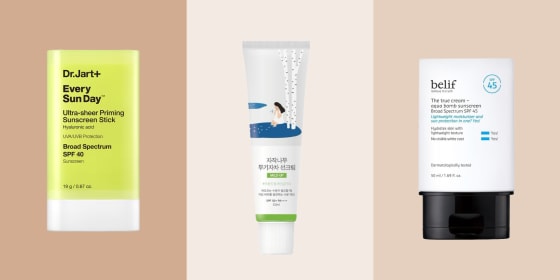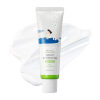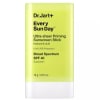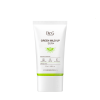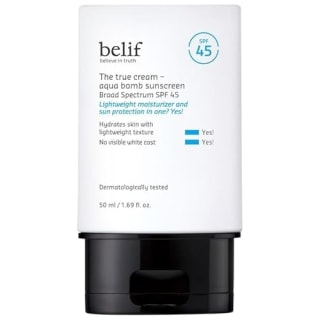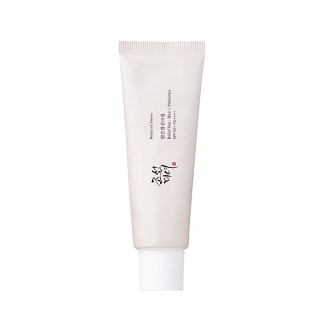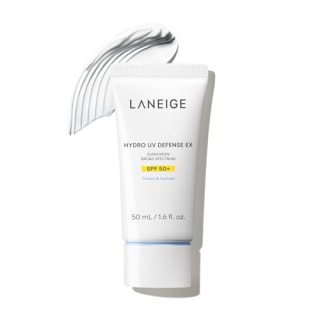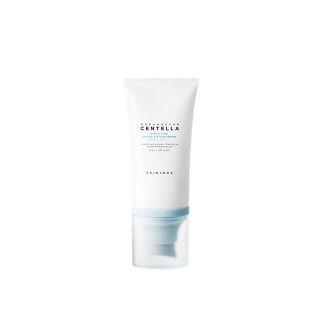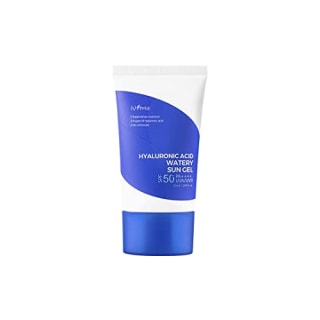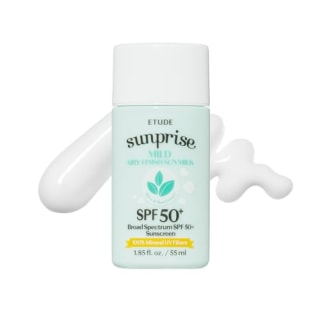Every year, Korean beauty brands like Innisfree and Dr Jart+ (and their respective sunscreens) take center stage, claiming their title as one the many “it girls” of the sunny season. That comes down to how they differ from our American formulations.
Korean sunscreens are known for their lightweight, elegant formulas that absorb into the skin without leaving it feeling heavy or greasy, according to board-certified dermatologist Dr. Claire Chang. “Many Korean sunscreens are also formulated with skin care ingredients, like hyaluronic acid, niacinamide and Centella asiatica to improve skin health along with protecting the skin,” says Chang.
To learn more about Korean sunscreens, I spoke with board-certified dermatologists and a cosmetic chemist about why these are a go-to for so many when it comes to protecting their skin from potential sun damage. I also gathered their recommendations, NBC Select staff favorites and highly rated options. At the time of publication, the prices of each of these sunscreens are up-to-date; however, due to pending tariffs, prices may vary (more on this below).
SKIP AHEAD How I picked the best Korean sunscreens | The best Korean sunscreens | How to shop for Korean sunscreens | Why trust NBC Select?
How I picked the best Korean sunscreens
When gathering the best Korean sunscreens to shop, my experts recommend considering the following factors:
- Sunscreen type: There are three types of sunscreen: mineral, chemical and hybrid (a combination of both mineral and chemical). Mineral (or physical) sunscreens use active ingredients (zinc oxide and titanium dioxide) that sit on the surface of your skin and reflect UV light. Chemical sunscreens use chemical filters that absorb UV light and convert it into heat so your body can then release it, according to our experts. This list has both options, and I go more in-depth on the different types below.
- PA rating/SPF rating: According to our experts and the American Academy of Dermatology, sunscreen should have at least SPF 30 protection. Most K-beauty sunscreens list an SPF rating and a PA rating (the Korean version of our sunscreen rating system, which indicates UVA protection). PA+ indicates low UVA protection, while PA++++ means the sunscreen has very high protection.
- Price: Sunscreens can vary in cost depending on their size and ingredient list. This list has options as low as $9 and as high as $35.
Want more from NBC Select? Sign up for our newsletter, The Selection, and shop smarter.
The best Korean beauty sunscreens
Best overall: Round Lab Birch Juice Moisturizing UVLock SPF 45
- Doesn’t pill
- Soothing
- Has blue light protection
- Nothing to note at this time
This silky sunscreen moisturizes your skin without clogging your pores, according to Chang. It has niacinamide to brighten and calm skin, along with amino acids and minerals to reduce texture and inflammation, according to the brand. It’s also a favorite of NBC Select Page Elliott Hyon because it’s hydrating and leaves a dewy finish on his skin. “It has no white cast and has the smoothest application out of any skin product I have,” he says.
Best moisturizer with SPF: Belif The True Cream Aqua Bomb SPF 45
- 2-in-1 formula
- Noncomedogenic
- Suitable for all skin tones
- Higher price point
Belif is one of our favorite Korean beauty brands, and board-certified dermatologist Dr. Jane Yoo recommends this moisturizer with SPF. Not only does it hydrate and protect the skin, but the non-greasy moisturizing cream also has marigold extract to improve the skin barrier. It also jas noni extract to even out your skin tone and boost elasticity, according to the brand.
Most soothing: Innisfree Daily UV Defense Sunscreen Broad Spectrum SPF 36
- Suitable for all skin types
- Doesn’t pill
- Available in two sizes
- Has added fragrance
Yoo recommends this chemical sunscreen, which has ingredients like green tea, sunflower seed oil and cica to hydrate, nourish and soothe the skin. Reviewers say this SPF has a rich texture that gives the skin a glowy finish.
Best for oily skin: Dr. Jart+ Every Sun Day Invisible Korean Sunscreen Stick SPF 40
- Easy to apply
- Portable
- Lightweight
- Higher price point
Dr. Jart+, one of our favorite K-beauty brands, recently expanded its sun care lineup with this stick sunscreen. It hydrates and primes the skin while simultaneously blurring pores, which makes it great to apply underneath makeup, according to the brand.
This sunscreen moisturized my skin and didn’t leave a white cast on my medium-tan complexion. The best part is that it’s not messy like other sunscreens, making it easy to apply and reapply the stick formula throughout the day. Plus, I can easily take it with me on the go (which will come in handy for summer trips).
Most nourishing: Beauty of Joseon Relief Sun: Rice+ Probiotics
- For all skin types
- Serum-like consistency
- No white cast
- May be hard to squeeze out
Chang recommends this lightweight sunscreen because it’s excellent for all skin types and tones, plus it absorbs quickly into the skin and layers well under makeup, she says. Chang also loves how hydrating it is since it’s enriched with rice extracts and probiotics.
Best for a dewy finish: Laneige Hydro UV Defense Sunscreen Broad Spectrum SPF 50+
- Non-greasy
- Hypoallergenic
- Absorbs quickly
- Higher price point
- May not be best for oily skin
Reviewers love this sunscreen, which comes recommended by Yoo, because it’s moisturizing and leaves their skin looking supple, dewy and glowing. The hydrating sunscreen is thick upon application, but blends in well so it doesn’t feel too thick on the skin, reviewers say. However, because of this, some reviewers say they find it a little too heavy for their oily and acne-prone skin. This has a 4.5-star average rating from over 230 reviews on Amazon.
Best for sensitive skin: Dr. G Green Mild Up Sunscreen
- Soothing
- Matte finish
- Color corrects
- Needs time to blend in
Hyon loves using this sunscreen because it balances out the ruddiness in his skin, counteracts redness and combats his eczema flare-ups. “Because it is a physical sunscreen, it does have a slight white cast upon initial application, but it absorbs into the skin very quickly,” he says. “Other physical sunscreens that I’ve used stay white and make me look ghostly and pale, but this one doesn’t stand out as much.”
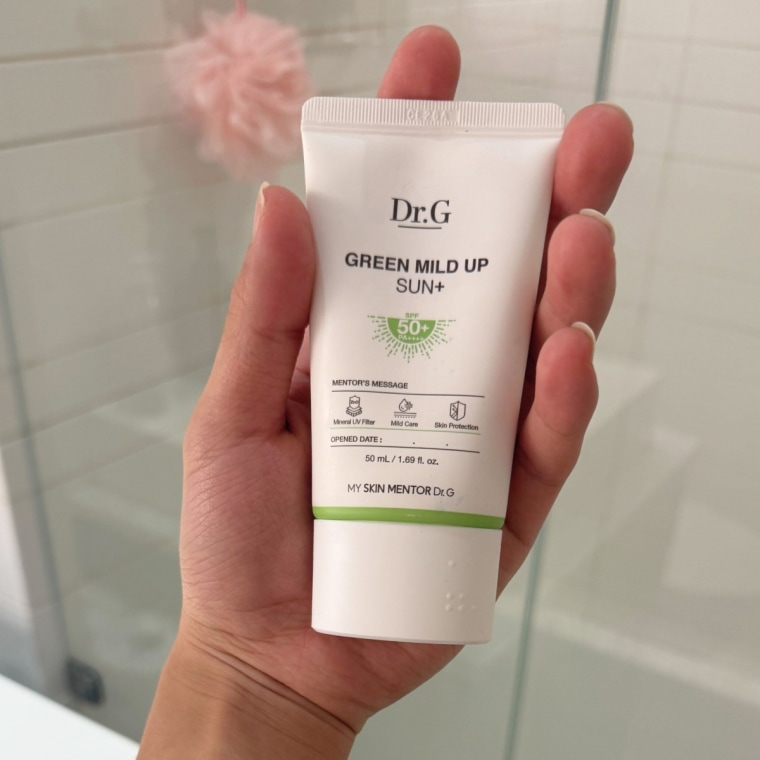
Best for dry skin: Skin1004 Madagascar Centella Hyalu-Cica Water-Fit Sun Serum
- Easy to dispense
- Absorbs quickly
- Reef-safe
- Minimal stickiness
This chemical sunscreen has Centella asiatica, which is gentle enough for sensitive skin and won’t trigger any breakout or flare-ups, according to the brand. It also has hyaluronic acid to hydrate and plump your skin, leaving it protected and dewy all at once, says Chang. Reviewers love how it easily blends into their skin, so it doesn’t feel heavy or sticky on the surface.
Best for combination skin: Isntree Hyaluronic Acid Watery Sun Gel
- Improves skin barrier
- Non-sticky
- Gentle and soothing
- Not great in humid weather
Another one in Hyon’s sunscreen rotation is this hydrating sun gel from Isntree, which has eight types of hyaluronic acid. “It has a nice runny texture that applies very smoothly and blends into the skin,” he says. “It is definitely not waterproof or sweatproof, so it doesn’t hold up in humid weather, but I love it because it doesn’t have any silicones, which is great for my combination skin.”
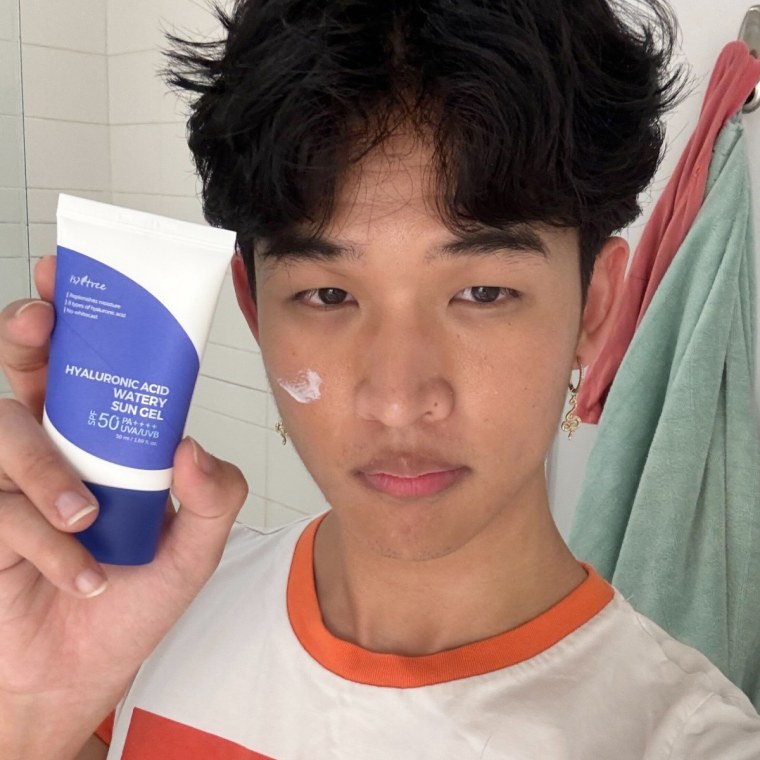
Best for darker skin tones: Etude Sunprise Mild Airy Finish Sun Milk SPF50+
- Liquid consistency
- Velvet finish
- Blends in easily
- Has a floral scent
“I’ve searched high and low for a sunscreen that doesn’t leave a white cast, flake or feel greasy, and my skin care routine became whole once I found Etude,” says NBC Select editorial operations associate Jem Alabi. “The mineral sunscreen, which is more like a gel, leaves my skin moisturized all day, has helped so much with my hyperpigmentation, and is the perfect consistency for my combination skin.”

Best for skin barrier health: KraveBeauty Beet The Sun SPF 40 PA+++ Broad Spectrum Sunscreen
- Non-greasy
- Suitable for all skin tones
- Moisturizing
- Tube can be messy
This sunscreen has hyaluronic acid, propanediol, vitamin E and beetroot extract to draw in and retain moisture, and reinforce the skin barrier, according to the brand. Reviewers of varying skin types say this sun lotion, which has a 4.4-star average rating from over 250 reviews on Amazon, is extremely lightweight, non-greasy and blends seamlessly into their skin.
How to shop for Korean sunscreens
When choosing a K-beauty sunscreen, you should consider several factors, including ingredients, skin type and sun protection.
Mineral vs. chemical sunscreen
- Mineral sunscreens, or physical sunscreens, block UV light from reaching our skin by using active ingredients like zinc oxide and titanium dioxide to reflect it from the surface. Because these ingredients sit on the surface of the skin, they tend to be less irritating, making them great options for those with sensitive or reactive skin, experts say.
- Chemical sunscreens have chemical filters that absorb UV light and convert it into heat, so they’re released by our bodies. Some of the most common chemical filters include octisalate, homosalate, oxybenzone, avobenzone, octocrylene and octinoxate. Typically, these are easier to blend, don’t leave behind a white cast and feel more lightweight, according to our experts.
Ingredients and skin type
Aside from the active ingredients in your K-beauty sunscreen that dictate whether it’s a chemical, mineral or hybrid, you’ll also find additional ingredients that will help your skin type and concerns. For example, hyaluronic acid, ceramides, glycerin and panthenol in sunscreen are hydrating ingredients that are great for those with dry skin, according to Chang. If you have dull, uneven or photodamaged skin, you’ll want to find options with antioxidants and brightening ingredients like vitamin C and niacinamide, she says.
Meet our experts
At NBC Select, we work with experts who have specialized knowledge and authority based on relevant training and/or experience. We also take steps to ensure all expert advice and recommendations are made independently and without undisclosed financial conflicts of interest.
- Dr. Claire Chang, is a board-certified dermatologist and fellowship-trained cosmetic dermatologist at UnionDerm in New York City. She is also a clinical instructor of dermatology at the Mount Sinai Medical Center.
- Dr. Jane Yoo, is a dual board-certified dermatologist and Mohs surgeon in New York City. She is also clinical assistant professor of dermatology at Icahn School of Medicine at Mount Sinai and a spokesperson for the Skin Cancer Foundation.
- Dr. Shuting Hu is a cosmetic chemist and founder and CEO of Acaderma.
Why trust NBC Select?
I am an associate reporter at NBC Select covering beauty, including new product launches and articles such as the best SPF lip balms and scalp sunscreens. For this piece, I interviewed dermatologists and a cosmetic chemist to learn more about the difference between Korean sunscreens and American sunscreens. I also recommended products the dermatologists shared with me as well as NBC Select-staff favorites and highly rated options on the market that align with my experts’ shopping guidance.
Catch up on NBC Select’s in-depth coverage of tech and tools, wellness and more, and follow us on Facebook, Instagram, Twitter and TikTok to stay up to date.
